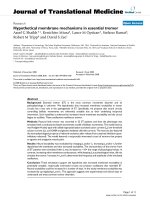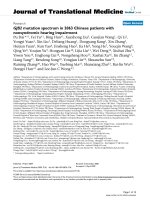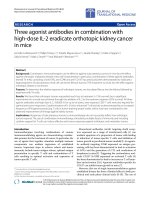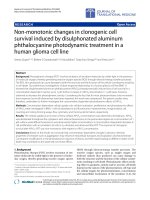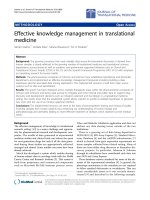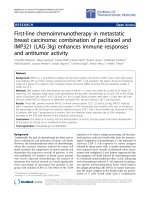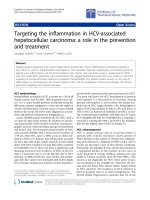Báo cáo hóa học: " Ultraviolet Laser Action in Ferromagnetic Zn12xFexO Nanoneedles" ppt
Bạn đang xem bản rút gọn của tài liệu. Xem và tải ngay bản đầy đủ của tài liệu tại đây (363.46 KB, 5 trang )
NANO EXPRESS
Ultraviolet Laser Action in Ferromagnetic Zn
12x
Fe
x
O
Nanoneedles
H. Y. Yang
•
S. F. Yu
•
S. P. Lau
•
T. S. Herng
•
M. Tanemura
Received: 13 August 2009 / Accepted: 16 October 2009 / Published online: 1 November 2009
Ó to the authors 2009
Abstract Fe-doped ZnO nanoneedles (NDs) were fabri-
cated by an Ar
?
ion sputtering technique operated at room
temperature. The as-grown samples show both ferromag-
netic and lasing properties. The saturated magnetization
moment was measured from 0.307 to 0.659 emu cm
-3
at
the field of 10 kOe with various Fe concentrations. Intense
ultraviolet random lasing emission was observed from
Zn
1 - x
Fe
x
O NDs at room temperature. The X-ray photo-
electron spectroscopy result reveals that the doped Fe
atoms occupy the Zn sites and lead to a decrease in oxygen
deficiency.
Keywords Zn
1 - x
FexO Á Nanoneedles Á Ferromagnetic Á
Random lasing Á Ion beam
ZnO-based diluted magnetic semiconductors (DMSs) have
attracted great research attention due to a high Curie
temperature above 300 K as predicted by theoretical cal-
culation [1, 2]. Recently, ZnO-based DMSs bulk materials
and thin films doped with Mn [3], Cu [4], Fe [5], and Co [6]
have been realized by various fabrication methods. On the
other hand, developing one-dimensional (1D) DMS
materials are of great interest, for the reason that the 1D
nanomaterials are ideal research systems for fabricating
nanoscale field effect transistors, sensors, optoelectronic
devices, logic circuits, and lasers [7]. Hence, 1D ZnO DMS
material has been prepared by vapor–solid process and
incorporation doping in the precursors [8–10]. However,
these fabrication methods may lead to variance in envi-
ronment of doping element in the matrix or forming second
phase. Ideally, the combination of ferromagnetism and
optical properties in 1D DMS material can open many new
possibilities of freedom and functionality for the fabrica-
tion of unique nano-devices. Hence, few research groups
have focused their investigation on the study of the photon
luminance and stimulated emission from the DMS mate-
rials [11, 12]. Nevertheless, there is no report on the
observation of the random lasing emissions from DMS
materials.
In this letter, we established an effective fabrication
method to realize 1D Fe-doped ZnO nanoneedles (NDs)
which support random lasing action at ultraviolet (UV)
wavelength. The surface morphology of an as-grown
sample was characterized by scanning electron microscopy
(SEM). X-ray diffraction (XRD) and transmission electron
microscope (TEM) were also employed to investigate the
crystallinity, which shows the Fe atoms have been doped
into the ZnO lattice. Furthermore, the ferromagnetic and
lasing properties of Zn
1 - x
Fe
x
O NDs have been investi-
gated. The X-ray photoelectron spectroscopy (XPS) was
used to find out the oxygen deficiency changing in the
slightly doped Zn
1 - x
Fe
x
O NDs sample.
As shown in Fig. 1a, Zn
1 - x
Fe
x
O NDs were fabricated
in ZnO thin films by an ion-beam system. The fabrication
procedures are similar to ZnO NDs which have been
reported elsewhere [13]. In brief, 400 nm-ZnO thin films
are deposited on SiO
2
/Si substrate by a filtered cathodic
H. Y. Yang (&) Á S. F. Yu Á T. S. Herng
School of Electrical and Electronic Engineering, Nanyang
Technological University, Nanyang 639798, Singapore
e-mail:
S. P. Lau
Department of Applied Physics, The Hong Kong Polytechnic
University, Hung Hom, Kowloon, Hong Kong
M. Tanemura
Graduate School of Engineering, Nagoya Institute of
Technology, Gokiso-Cho, Showa-Ku, Nagoya 466-8555, Japan
123
Nanoscale Res Lett (2010) 5:247–251
DOI 10.1007/s11671-009-9473-9
vacuum arc (FCVA) technique at 200 °C. 3 keV Ar
?
ions
were focused into a microbeam with 380 lm in diameter
for sputtering the thin films in a vacuum reaction chamber.
At the same time, an arc plasma gun with Fe ion source
was operated in pulse modes at 0.2, 0.5, and 1.0 Hz to dope
Fe atom in the new forming ZnO NDs, and the corre-
sponding Fe content in the Zn
1 - x
Fe
x
O NDs was estimated
to be *1.1, 1.7 and 3.5 at. %, respectively, by the XPS
analysis. Figure 1b shows the XRD h–2h scan of the as-
grown samples. It is found that only (002) reflections were
detected, which confirmed c-axis dominated structure of
the samples. No secondary phase was found from the XRD
spectrum, which indicated that the doping Fe must be
incorporated into the lattice as substitution atom. However,
for Zn
0.965
Fe
0.035
O sample, clear decreases of intensity and
increase in FWHM of the XRD peaks were detected. These
results implied that when x C 0.035, the crystal-quality of
the Zn
1 - x
Fe
x
O sample has decreased dramatically, even
though there is no formation of secondary phase and pre-
cipitates in this doping concentration. An expansion in
Fig. 1 a The geometrical
configuration of ion-beams
sputtering and Fe doping
process. b XRD results of
as-synthesized sample. c SEM
images of Zn
0.989
Fe
0.011
O NDs.
d TEM image of a single
Zn
0.989
Fe
0.011
O nanoneedle.
e High-resolution TEM image
of the nanoneedle and f the
corresponding selected area
electron diffraction pattern
248 Nanoscale Res Lett (2010) 5:247–251
123
lattice constant can be also seen from the XRD spectrum,
the corresponding lattice expansion is calculated from the
peak shift as Dc/c = 2.43% in the 3.5% Fe-doped sample.
Figure 1c shows the high magnification SEM image of
as-deposited Zn
0.989
Fe
0.011
O nanoneedle arrays with sharp-
tip morphology. The diameter and length of the NDs are in
the order of *100 and 600 nm, respectively. It can be seen
that the separation between the NDs was irregular and
ranged from a few nanometers to tens of nanometers. As
the ZnO thin film was only 400 nm thick, the upper part of
the cone was Zn
0.989
Fe
0.011
O (black contrast) and the lower
part of the stem was SiO
2
. A cross-sectional TEM image of
a single Zn
0.989
Fe
0.011
O nanoneedle (Fig. 1d), high-reso-
lution TEM image (Fig. 1e) and the corresponding selec-
tive area electron diffraction (SAED) pattern (Fig. 1f) are
exemplified to illustrate the crystal-quality of the
Zn
0.989
Fe
0.011
O NDs. The SAED pattern of the NDs is
matched with the simulated ZnO pattern, implying that the
nanoneedle exhibited the ZnO wurtzite structure. However,
some weak diffraction spots of Fe
2
O
3
could be seen in the
pattern. Lattice distortion can also be observed in Fig. 1e.
This is primarily due to the lattice constant mismatch
between ZnO and the secondary phases (Fe
2
O
3
) as they
have different crystal structures. These TEM results further
illustrate the existence of the Fe element in the ZnO lattice
which results to the ferromagnetism in ZnO NDs (Fig. 2).
In order to analyze the Fe doping of prepared sample,
we measured the magnetization versus applied magnetic
field curves for the Zn
1 - x
Fe
x
O NDs at with different
compositions. The measurement was done 300 K by an
alternating gradient magnetometer with a maximum field
of 10 kOe. The Zn
1 - x
Fe
x
O NDs exhibit saturated room
temperature magnetic moment (M
s
) of 0.29, 0.37, and
0.66 emu g
-1
with the Fe concentration as 1.1, 1.7, and 3.5
at.%, respectively. The well-defined hysteresis loops with
coercive fields (H
c
)of*75, 97, and 275 Oe in these three
samples implying the ferromagnetic properties at room
temperature. These trends with doping concentration have
been plot in the insert.
Investigations of the optical characteristics of the
Zn
1 - x
Fe
x
O NDs samples were carried out by a 355 nm
frequency–tripled Nd: YAG (10 Hz, 6 ns) pulse laser.
Figure 3a, b, and c show the lasing spectra of the undoped
ZnO, Zn
0.989
Fe
0.011
O, and Zn
0.983
Fe
0.017
O NDs, respec-
tively, as a function of optical excitation. When the pump
power reached the threshold, Ith, a dramatic emission
oscillation in a linewidth as narrow as 0.4 nm emerged
from the single-broad emission spectra. Multiple laser
modes with strong coherent feedback at wavelengths at the
center wavelength *394 nm (i.e., ZnO NDs), *398 nm
(Zn
0.989
Fe
0.011
O NDs), and *405 nm (Zn
0.983
Fe
0.017
O
NDs) were detected from these three NDs samples at room
temperature. These lasing characteristics detected from all
these NDs samples are in good agreements with our pre-
vious observation [14], which are due to random laser
action. It should be also noted here, no lasing emission can
be detected from Zn
0.965
Fe
0.035
O sample even under a
pumping intensity as high as *1.6 MW cm
-2
, which is
expected due to the significant lattice deformation in this
sample (i.e., shown from XRD results). A redshift up to
*11 nm was found in the emission wavelength. This kind
of redshift in optical properties was also found in Co-doped
Fig. 2 Magnetization
hysteresis loops of Zn
1 - x
Fe
x
O
NDs at 300 K. Insert shows the
saturated magnetization (M
s
)
and magnetic ordering with
coercivity (H
c
) as a function of
Fe concentration
Nanoscale Res Lett (2010) 5:247–251 249
123
ZnO thin films [15]. The reason was proposed as that the
sp-d exchange interactions between band electrons and
localized d electrons of the Co
2?
ions substituting for Zn
ions. The redshift in our Fe-doped ZnO samples may also
due to this reason. The electrons interchange give rise to a
negative and a positive correction to the conduction- and
valence-band edges, which lead to shrinkage of the band
gap [16, 17].
Figure 3d shows the plots of emission intensity versus
pumping intensity (i.e., light–light curve) of undoped ZnO,
Zn
0.989
Fe
0.011
O, and Zn
0.983
Fe
0.017
O NDs, respectively.
Remarkably, it shows that the lasing threshold is decreased
with slightly doped sample (i.e., x = 0.011), whereas
increase to *0.47 MW cm
-2
when x increase to 0.017. It
is known that the incorporation of 3d transition ions, such
as Fe, generally deteriorates the crystallinity of ZnO due to
their low solubility and various valence states [18], which
is the mean reason for the increase of lasing threshold in
the Zn
0.983
Fe
0.017
O sample. This also suggested the
increase in optical properties of Zn
0.989
Fe
0.011
O sample.
Hence, the slightly doped Fe can improve the crystallinity
of undoped ZnO NDs. To compare the defects in the lattice
of slightly Fe-doped ZnO and undoped ZnO NDs, we
carryout XPS analysis for these two samples.
Figure 4 shows the XPS results from undoped and
Fe-doped ZnO NDs. It was found that the chemical shift
and signal intensity of Zn 2p
1/2
and Zn 2p
3/2
(data not
shown) are similar in all these samples. The XPS data of
Zn
0.989
Fe
0.011
O NDs are shown in Fig. 4a. The insert figure
shows the Fe 2p
1/2
and Fe 2p
3/2
peaks located at 724.9 and
710.5 eV, respectively. Figure 4b, c, and d demonstrate O
1s peak and its deconvolution results for undoped ZnO and
Fe-doped NDs. The deconvolution of peak was performed
using a Gaussian distribution. According to literature, there
are three types of oxygen energy levels existing in ZnO
samples, i.e., O
2-
of oxygen deficiency (i.e., 529.3 eV),
O
2-
in ZnO structure (i.e., 531.6 eV), and the chemically
absorbed oxygen site (i.e., 534.1 eV) [19–21]. Although
the Fe-doped ZnO NDs exhibited a slightly higher O 1s
binding energy (i.e., 532.2 and 531.8 eV), the O
2-
in
Zn
0.989
Fe
0.011
O structure has a similar amount of signal
compare to undoped ZnO NDs. However, a significant
reduction in the signal for oxygen deficiencies
(*529.3 eV) was found in the slightly doped NDs. It is
strongly implied that Fe is selectively bonded to electrons
in singly ionized oxygen vacancies, which may increase the
crystallinity of the sample. It has been reported that the Fe
ions bonded to electrons can also reduce the chance of
recombination of the electrons and photoexcited holes in
the valence band [19, 22], which can deduce the green
emission results from the recombination of electrons in
singly ionized oxygen vacancies and photoexcited holes.
Consequently, slightly doping of Fe into ZnO nanostruc-
tures decreased the oxygen deficiency, which results in the
improvement of optical properties.
In summary, we have demonstrated successfully the in
situ dope of Fe into ZnO NDs by ion sputtering method.
Ferromagnetic characteristics of the Fe-doped ZnO NDs
Fig. 3 Lasing emission spectra
obtained from a undoped ZnO
NDs, b Zn
0.989
Fe
0.011
O NDs,
and c Zn
0.983
Fe
0.017
O NDs
under different pumping density
where the Ith represents the
lasing threshold. d Light–light
curves of the undoped ZnO,
Zn
0.989
Fe
0.011
O, and
Zn
0.983
Fe
0.017
O NDs
250 Nanoscale Res Lett (2010) 5:247–251
123
have been observed at room temperature. The UV lasing
emissions from these magnetic NDs were also investigated.
XPS measurements showed that oxygen deficiencies can be
significantly reduced by slightly Fe doping in ZnO NDs.
By combining magnetic and lasing functionality, these Fe-
doped ZnO NDs have high potential to be used in variety of
short wavelength optical devices, such as spin-polarized
light emitters, spin-laser diodes, and optical switches and
modulators.
Acknowledgments This work was supported by LKY PDF 2/08
startup grant.
References
1. S.A. Wolf, D.D. Awschalom, R.A. Buhrman, J.M. Daughton, S.
von Molna
´
r, M.L. Roukes, A.Y. Chtchelkanova, D.M. Treger,
Science 294, 1488 (2000)
2. T. Dietl, H. Ohno, F. Matsukura, J. Cibert, D. Ferrand, Science
287, 1019 (2000)
3. Z. Yang, J.L. Liu, M. Biasini, W.P. Beyermann, Appl. Phys. Lett.
92, 042111 (2008)
4. T.S. Herng, S.P. Lau, S.F. Yu, H.Y. Yang, X.H. Ji, J.S. Chen, N.
Yasui, H. Inaba, J. Appl. Phys. 99, 086101 (2006)
5. A.J. Chen, X.M. Wu, Z.D. Sha, L.J. Zhuge, Y.D. Meng, J. Phys.
D Appl. Phys. 39, 4762 (2006)
6. J.M. Baik, J.L. Lee, Adv. Mater. 17, 2745 (2005)
7. Z.L. Wang, Adv. Mater. 19, 889 (2007)
8. C.X. Xu, X.W. Sun, Z.L. Dong, M.B. Yu, Y.Z. Xiong, J.S. Chen,
Appl. Phys. Lett. 86, 173110 (2005)
9. X.M. Zhang, Y. Zhang, Z.L. Wang, W.J. Mai, Y.D. Gu, W.S.
Chu, Z.Y. Wu, Appl. Phys. Lett. 92, 162102 (2008)
10. J.J. Liu, M.H. Yu, W.L. Zhou, Appl. Phys. Lett. 87, 172505
(2005)
11. J. Antony, S. Pendyala, A. Sharma, X.B. Chen, J. Morrison, L.
Bergman, Y. Qiang, J. Appl. Phys. 97, 10D307 (2005)
12. C. Ronning, P.X. Gao, Y. Ding, Z.L. Wang, D. Schwen, Appl.
Phys. Lett. 84, 783 (2004)
13. S.P. Lau, H.Y. Yang, S.F. Yu, H.D. Li, M. Tanemura, T. Okita,
H. Hatano, H.H. Hng, Appl. Phys. Lett. 87, 013104 (2005)
14. S.P. Lau, H.Y. Yang, S.F. Yu, C. Yuen, E.S.P. Leong, H.D. Li,
H.H. Hng, Small 1, 956 (2005)
15. M. Tay, Y.H. Wu, G.C. Han, T.C. Chong, Y.K. Zheng, S.J.
Wang, Y.B. Chen, X.Q. Pan, J. Appl. Phys. 100, 063910 (2006)
16. K.J. Kim, Y.R. Park, Appl. Phys. Lett. 81, 1420 (2002)
17. Y.Z. Yoo, J. Appl. Phys. 90, 4246 (2001)
18. T.S. Herng, S.P. Lau, S.F. Yu, H.Y. Yang, L. Wang, M.
Tanemura, J.S. Chen, Appl. Phys. Lett. 90, 032509 (2007)
19. S.H. Baek, J.J. Song, S.W. Lim, Physica B Condens. Matt. 339,
101 (2007)
20. M.N. Islam, T.B. Ghosh, K.L. Chopra, H.N. Acharya, Thin Solid
Films 280, 20 (1996)
21. M. Chen, X. Wang, Y.H. Yu, Z.L. Pei, X.D. Bai, C. Sun, R.F.
Huang, L.S. Wen, Appl. Surf. Sci. 158, 134 (2000)
22. K. Vanheusden, C.H. Seager, W.L. Warren, D.R. Tallant, J.A.
Voigt, Appl. Phys. Lett. 68, 403 (1996)
Fig. 4 a XPS spectra of
Zn
0.989
Fe
0.011
O NDs, the insert
shows the Fe 2p XPS core-level
spectra; O 1s XPS core-level
spectra of b undoped ZnO NDs,
c Zn
0.989
Fe
0.011
O NDs, and
d Zn
0.983
Fe
0.017
O NDs
Nanoscale Res Lett (2010) 5:247–251 251
123

